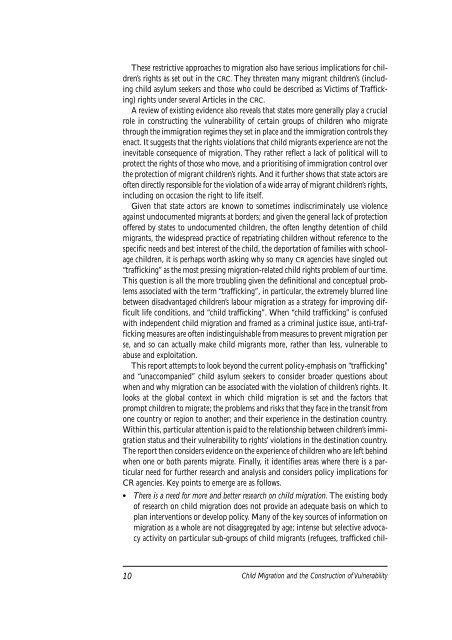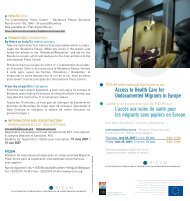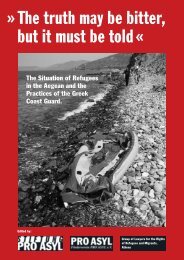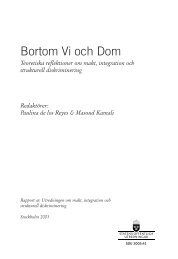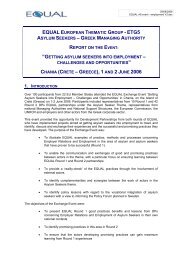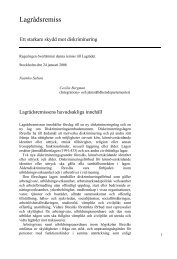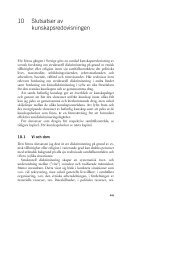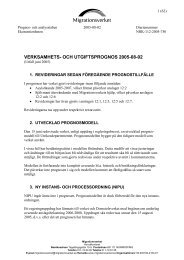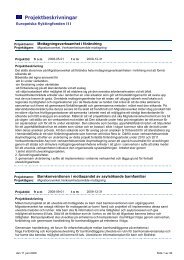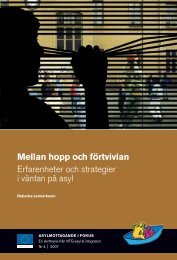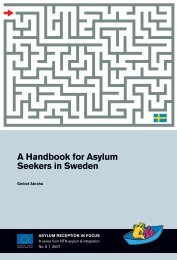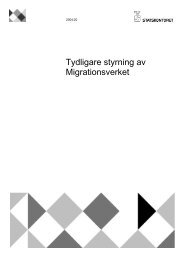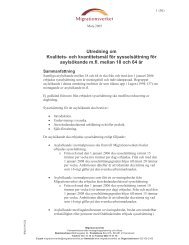and the Construction of Vulnerability - Child Trafficking
and the Construction of Vulnerability - Child Trafficking
and the Construction of Vulnerability - Child Trafficking
You also want an ePaper? Increase the reach of your titles
YUMPU automatically turns print PDFs into web optimized ePapers that Google loves.
These restrictive approaches to migration also have serious implications for children’s<br />
rights as set out in <strong>the</strong> CRC. They threaten many migrant children’s (including<br />
child asylum seekers <strong>and</strong> those who could be described as Victims <strong>of</strong> <strong>Trafficking</strong>)<br />
rights under several Articles in <strong>the</strong> CRC.<br />
A review <strong>of</strong> existing evidence also reveals that states more generally play a crucial<br />
role in constructing <strong>the</strong> vulnerability <strong>of</strong> certain groups <strong>of</strong> children who migrate<br />
through <strong>the</strong> immigration regimes <strong>the</strong>y set in place <strong>and</strong> <strong>the</strong> immigration controls <strong>the</strong>y<br />
enact. It suggests that <strong>the</strong> rights violations that child migrants experience are not <strong>the</strong><br />
inevitable consequence <strong>of</strong> migration. They ra<strong>the</strong>r reflect a lack <strong>of</strong> political will to<br />
protect <strong>the</strong> rights <strong>of</strong> those who move, <strong>and</strong> a prioritising <strong>of</strong> immigration control over<br />
<strong>the</strong> protection <strong>of</strong> migrant children’s rights. And it fur<strong>the</strong>r shows that state actors are<br />
<strong>of</strong>ten directly responsible for <strong>the</strong> violation <strong>of</strong> a wide array <strong>of</strong> migrant children’s rights,<br />
including on occasion <strong>the</strong> right to life itself.<br />
Given that state actors are known to sometimes indiscriminately use violence<br />
against undocumented migrants at borders; <strong>and</strong> given <strong>the</strong> general lack <strong>of</strong> protection<br />
<strong>of</strong>fered by states to undocumented children, <strong>the</strong> <strong>of</strong>ten lengthy detention <strong>of</strong> child<br />
migrants, <strong>the</strong> widespread practice <strong>of</strong> repatriating children without reference to <strong>the</strong><br />
specific needs <strong>and</strong> best interest <strong>of</strong> <strong>the</strong> child, <strong>the</strong> deportation <strong>of</strong> families with schoolage<br />
children, it is perhaps worth asking why so many CR agencies have singled out<br />
“trafficking” as <strong>the</strong> most pressing migration-related child rights problem <strong>of</strong> our time.<br />
This question is all <strong>the</strong> more troubling given <strong>the</strong> definitional <strong>and</strong> conceptual problems<br />
associated with <strong>the</strong> term “trafficking”, in particular, <strong>the</strong> extremely blurred line<br />
between disadvantaged children’s labour migration as a strategy for improving difficult<br />
life conditions, <strong>and</strong> “child trafficking”. When “child trafficking” is confused<br />
with independent child migration <strong>and</strong> framed as a criminal justice issue, anti-trafficking<br />
measures are <strong>of</strong>ten indistinguishable from measures to prevent migration per<br />
se, <strong>and</strong> so can actually make child migrants more, ra<strong>the</strong>r than less, vulnerable to<br />
abuse <strong>and</strong> exploitation.<br />
This report attempts to look beyond <strong>the</strong> current policy-emphasis on “trafficking”<br />
<strong>and</strong> “unaccompanied” child asylum seekers to consider broader questions about<br />
when <strong>and</strong> why migration can be associated with <strong>the</strong> violation <strong>of</strong> children’s rights. It<br />
looks at <strong>the</strong> global context in which child migration is set <strong>and</strong> <strong>the</strong> factors that<br />
prompt children to migrate; <strong>the</strong> problems <strong>and</strong> risks that <strong>the</strong>y face in <strong>the</strong> transit from<br />
one country or region to ano<strong>the</strong>r; <strong>and</strong> <strong>the</strong>ir experience in <strong>the</strong> destination country.<br />
Within this, particular attention is paid to <strong>the</strong> relationship between children’s immigration<br />
status <strong>and</strong> <strong>the</strong>ir vulnerability to rights’ violations in <strong>the</strong> destination country.<br />
The report <strong>the</strong>n considers evidence on <strong>the</strong> experience <strong>of</strong> children who are left behind<br />
when one or both parents migrate. Finally, it identifies areas where <strong>the</strong>re is a particular<br />
need for fur<strong>the</strong>r research <strong>and</strong> analysis <strong>and</strong> considers policy implications for<br />
CR agencies. Key points to emerge are as follows.<br />
● There is a need for more <strong>and</strong> better research on child migration. The existing body<br />
<strong>of</strong> research on child migration does not provide an adequate basis on which to<br />
plan interventions or develop policy. Many <strong>of</strong> <strong>the</strong> key sources <strong>of</strong> information on<br />
migration as a whole are not disaggregated by age; intense but selective advocacy<br />
activity on particular sub-groups <strong>of</strong> child migrants (refugees, trafficked chil-<br />
10<br />
<strong>Child</strong> Migration <strong>and</strong> <strong>the</strong> <strong>Construction</strong> <strong>of</strong> <strong>Vulnerability</strong>


